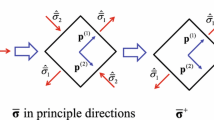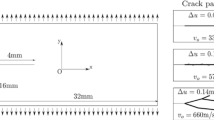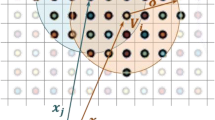Abstract
In this work, a micro-crack informed stochastic damage analysis is performed to consider the failures of material with stochastic microstructure. The derivation of the damage evolution law is based on the Helmholtz free energy equivalence between cracked microstructure and homogenized continuum. The damage model is constructed under the stochastic representative volume element (SRVE) framework. The characteristics of SRVE used in the construction of the stochastic damage model have been investigated based on the principle of the minimum potential energy. The mesh dependency issue has been addressed by introducing a scaling law into the damage evolution equation. The proposed methods are then validated through the comparison between numerical simulations and experimental observations of a high strength concrete. It is observed that the standard deviation of porosity in the microstructures has stronger effect on the damage states and the peak stresses than its effect on the Young’s and shear moduli in the macro-scale responses.

























Similar content being viewed by others
Change history
26 February 2018
After publication of the original article [1], it has come to our attention that a citation of article [2] was missed.
References
Hill R (1963) Elastic properties of reinforced solids: some theoretical principles. J Mech Phys Solids 11(5):357–372
Hazanov S (1998) Hill condition and overall properties of composites. Arch Appl Mech 68(6):385–394
Huet C (1990) Application of variational concepts to size effects in elastic heterogeneous bodies. J Mech Phys Solids 38(6):813–841
Huet C (1991) Hierarchies and bounds for size effects in heterogeneous bodies. Contin Models Discret Syst 2:127–134
Ostoja-Starzewski M (2006) Material spatial randomness: from statistical to representative volume element. Probab Eng Mech 21(2):112–132
Xu XF, Graham-Brady L (2005) A stochastic computational method for evaluation of global and local behavior of random elastic media. Comput Methods Appl Mech Eng 194(42):4362–4385
Lee K, Moorthy S, Ghosh S (1999) Multiple scale computational model for damage in composite materials. Comput Methods Appl Mech Eng 172(1):175–201
Fish J, Yu Q, Shek K (1999) Computational damage mechanics for composite materials based on mathematical homogenization. Int J Numer Methods Eng 45(11):1657–1679
Dascalu C, Bilbie G, Agiasofitou EK (2008) Damage and size effects in elastic solids: a homogenization approach. Int J Solids Struct 45(2):409–430
Ren X, Chen JS, Li J, Slawson TR, Roth MJ (2011) Micro-cracks informed damage models for brittle solids. Int J Solids Struct 48(10):1560–1571
Peirce FT (1926) Tensile tests for cotton yarns-“The Weakest Link” theorems on the strength of long and of composite specimens. J Text Inst 17:T355–368
Krajcinovic D, Silva MAG (1982) Statistical aspects of the continuous damage theory. Int J Solids Struct 18(7):551–562
Sfantos GK, Aliabadi MH (2007) Multi-scale boundary element modeling of material degradation and fracture. Comput Methods Appl Mech Eng 196(7):1310–1329
Wriggers P, Moftah SO (2006) Mesoscale models for concrete: homogenisation and damage behaviour. Finite Elem Anal Des 42(7):623–636
Fuller WB, Thompson SE (1906) The laws of proportioning concrete. Trans Am Soc Civil Eng 57(2):67–143
Xia ZH, Curtin WA (2001) Multiscale modeling of damage and failure in aluminum-matrix composites. Compos Sci Technol 61(15):2247–2257
Clément A, Soize C, Yvonnet J (2012) Computational nonlinear stochastic homogenization using a nonconcurrent multiscale approach for hyperelastic heterogeneous microstructures analysis. Int J Numer Methods Eng 91(8):799–824
Hardenacke V, Hohe J (2009) Local probabilistic homogenization of two-dimensional model foams accounting for micro structural disorder. Int J Solids Struct 46(5):989–1006
Bažant ZP, Belytschko TB, Chang TP (1984) Continuum theory for strain-softening. J Eng Mech 110(12):1666–1692
Belytschko T, Bažant ZP, Yul-Woong H, Ta-Peng C (1986) Strain-softening materials and finite-element solutions. Comput Struct 23(2):163–180
Pijaudier-Cabot G, Bažant ZP (1987) Nonlocal damage theory. J Eng Mech 113(10):1512–1533
Chen JS, Wu CT, Belytschko T (2000) Regularization of material instabilities by meshfree approximations with intrinsic length scales. Int J Numer Methods Eng 47(7):1303–1322
Chen JS, Zhang X, Belytschko T (2004) An implicit gradient model by a reproducing kernel strain regularization in strain localization problems. Comput Methods in Appl Mech Eng 193(27):2827–2844
Bazant ZP (1984) Size effect in blunt fracture: concrete, rock, metal. J Eng Mech 110(4):518–535
O’Daniel J (2010) Recent ERDC developments in computationally modeling concrete under high rate events. Army corps of engineers vicksburg MS engineer research and development center
Adley M, Frank A, Danielson K, Akers S, O’Daniel J (2010) The advanced fundamental concrete (AFC) model: TR-10-X. US Army Engineer Research and Development Center, Vicksburg
Bazant ZP, Caner FC, Carol I, Adley MD, Akers SA (2000) Microplane model M4 for concrete. I: formulation with work-conjugate deviatoric stress. J Eng Mech 126(9):944–953
Carol I, Rizzi E, Willam K (2002) An ‘extended’volumetric/deviatoric formulation of anisotropic damage based on a pseudo-log rate. Eur J Mech 21(5):747–772
Li J, Ren X (2009) Stochastic damage model for concrete based on energy equivalent strain. Int J Solids Struct 46(11):2407–2419
Heard WF (2014) Development and multi-scale characterization of a self-consolidating high-strength concrete for quasi-static and transient loads. Vanderbilt University, Nashville
Chan TF, Vese LA (2001) Active contours without edges. Image Process IEEE Trans 10(2):266–277
Rosenblatt M (1956) Remarks on some nonparametric estimates of a density function. Annal Math Statist 27(3):832–837
Parzen E (1962) On estimation of a probability density function and mode. Annal Math Stat 33(3):1065–1076
Lin SP (2014) A computational framework for the development of a stochastic micro-cracks informed damage model. University of California, Los Angeles, Department of Civil & Environmental Engineering
Moës N, Belytschko T (2002) Extended finite element method for cohesive crack growth. Eng Fract Mech 69(7):813–833
Acknowledgments
The support of this work by US Army Engineer Research and Development Center under contract W912HZ-07-C-0019 to UC San Diego for the first two authors, and National Science Foundation of China under Grant No. 91315301 to Tongji University for the third author are gratefully acknowledged.
Author information
Authors and Affiliations
Corresponding author
Additional information
A correction to this article is available online at https://doi.org/10.1007/s00466-017-1526-9.
Rights and permissions
About this article
Cite this article
Lin, SP., Chen, JS. & Liang, S. A damage analysis for brittle materials using stochastic micro-structural information. Comput Mech 57, 371–385 (2016). https://doi.org/10.1007/s00466-015-1247-x
Received:
Accepted:
Published:
Issue Date:
DOI: https://doi.org/10.1007/s00466-015-1247-x




